May 21, 2025 | 03:46 GMT +7
May 21, 2025 | 03:46 GMT +7
Hotline: 0913.378.918
May 21, 2025 | 03:46 GMT +7
Hotline: 0913.378.918
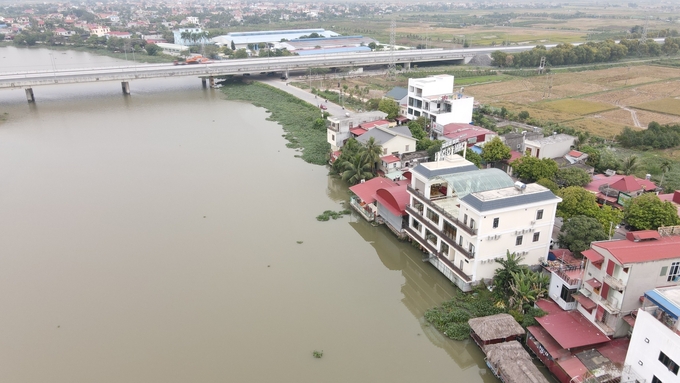
Restaurants and houses were built on the Da Do River in Kien Thuy district. Photo: Dinh Muoi.
To protect the water source in the irrigation system, Da Do Irrigation Works Exploitation One Member Company Limited (Da Do Company) have many drastic measures and implementations, but the quality of water sources is still getting worse and worse due to limited funding, discharge status, climate change and saline intrusion.
According to Da Do Company, over the past time, the unit has strengthened operation regulations and reversed the water source to minimize polluting agents. In addition, the construction of digital maps and installation of automatic equipment applied by the Company, ensuring regular updates of water level and hydro-meteorological developments in service of system operation.
Researching and successfully piloting “Equipment using solar energy to manage and operate the irrigation sluice system remotely” at Bai Vet sluice and Dong Cung sluice on Da Do Bank to strengthen the prevention of discharge into the irrigation system, and reduce water pollution in rivers.

Many solutions have been implemented, but the protection of the Da Do River water source is facing difficulties. Photo: Ba Thang.
Da Do Company has also mobilized people to join hands to clear 105 ha of ponds, farms in the riverbed, 2,000 m2 of houses and structures, and over 300,000 trees within the scope of the project. Simultaneously, embankment 60/90km on both sides of Da Do, renovate and upgrade 40/140 sluices on shore and renovate and dredge nearly 100km of grade 1 canals, upgrade over 50 works on the canal. On the other hand, 1,538 landmarks have been planted to mark the corridors to protect works and protect water sources on the Da Do River.
According to Mr Do Van Trai - Chairman of Da Do Company, in the process of protecting works and the water sources, the unit encountered many difficulties in funding sources and the shortcomings left by history and problems in mechanisms and policies.
For example, the handling of cases of encroachment and violation, and discharge of waste causing water pollution depends on the participation of local authorities and functional agencies, the level of punishment for violations is not enough of a deterrent.

Plastic recycling along the banks of Da Do River in Trang Minh ward, Kien An district has been going on for decades. Photo: Dinh Muoi.
The planning of residential land and the planning of traffic in some areas is not synchronized, people are given land close to irrigation canals without roads leading to spontaneous construction of bridges over the canals; the granting of land use rights within the scope of irrigation works since 1993 causing difficulties in the current clearing work.
Dam culverts on the banks of Da Do River are still not synchronized and closed while the irrigation works system is still receiving polluted wastewater every day and hour by hour, affecting the water quality of the system. Meanwhile, violations of discharge and encroachment offences are becoming more and more complicated.
According to statistics, currently on the two banks of Da Do River, there are a total of 140 crossing points, of which 40 sluices do not have sluice gates. 13 works are buse sluices or box culverts discharging domestic wastewater, 63 locations currently do not have regulation works and 25 discharge points directly into Da Do river.

The irrigation system is overloaded when performing two functions of "irrigation and drainage" at the same time in Thai Son commune, An Lao district. Photo: Dinh Muoi.
For locations without regulation works, most of them are points of water supply to canals managed by the locality. It is necessary to review the important water supply points that need to invest in sluices and plan the expansion of unnecessary sluices for investment, building clamping canals along the Da Do bank to regulate water in the area.
With the current situation of free discharge into the system and such a risk of saline pollution, if there is no protective solution, in the future, water sources will not be guaranteed to serve the development of people's lives. This unit has submitted a report proposing a plan to collect and redirect wastewater to Hai Phong City People's Committee.
Accordingly, the solution to protect the current Da Do river water source is to adjust the direction of wastewater discharge to Lach Tray and Van Uc rivers.
Specifically, with the discharge point in Cau Nguyet area, it is necessary to collect and divert wastewater from Ong Tam sluice area to Truong Son canal to drain Lach Tray River. It is necessary to completely clean Ong Tam culvert, and stone embankment and build the canal from Hai Phong Social Protection Center.
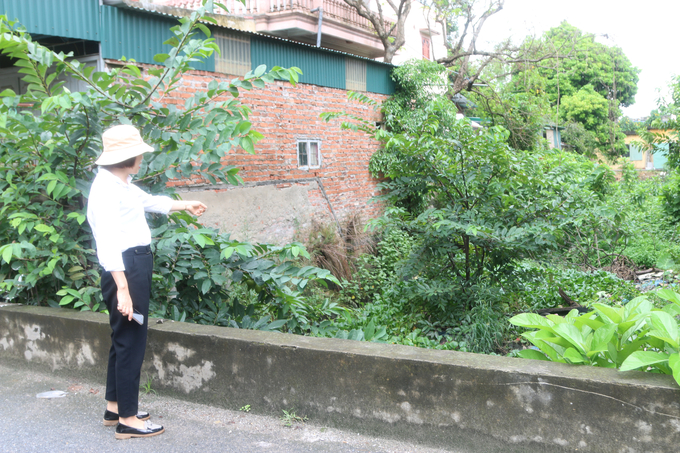
An irrigation canal in Kien An district no longer works, it is now a place to dump garbage, discharge domestic waste, and overgrown plants. Photo: Ba Thang.
The section from the roadside canal of the residential area to the Truong Son canal needs dredging, embankment and stone embankment to build a section of the canal to divert water to the canal and build a drainage culvert at the location where the canal bank crosses the canal without culverts, replace frequently clogged buse culverts with box culverts, build new regulating culverts at some locations.
Next, it is necessary to collect and divert wastewater in the residential area of My Duc commune to Thach Luu sluice, An Lao - Kien Thuy inter-district canal, and discharge it to the Van Uc river.
At the discharge point in Kien An district, it is necessary to renovate and upgrade the Do Vo 1 canal, Thang Loi Canal, and My Khe Canal and work on the canal to divert wastewater to the Lach Tray River.
In An Lao district, it is necessary to collect and divert wastewater from residential areas in Cau Vang 1 to Bai Vet canal, discharge to Lach Tray River, collect and divert wastewater from residential areas and industrial zones in Cau Vang 2 area to Cong Nghe canal and discharge to Van Uc river.
Particularly, in the area of Kien Thuy district, it is necessary to collect and divert wastewater from residential areas in the Cau Doi area to Duc Phong 1 canal and discharge it to Lach Tray River through C2 culvert. It also requires the embankment and reinforcement of the main canal of Da Do River and the construction of a sluice route from the foot of the Doi Bridge to the Hoa Binh Bridge.
The cost of implementing the plan of collecting, and diverting wastewater to protect water sources of Da Do irrigation system is expected to be about VND 763 billion from public investment capital (Hai Phong City budget). In which, the discharge point in Cau Nguyet area is VND 143 billion, the discharge point in Kien An district is VND 210 billion, An Lao district is VND 200 billion and Kien Thuy district is nearly VND 210 billion.
“To overcome the pollution of the water source of the main canal of the Da Do River to serve the city's clean water production, Hai Phong Department of Agriculture and Rural Development has asked the City People's Committee to approve the plan to collect and divert wastewater to protect the water source of the main canal of Da Do river at the above 4 wastewater discharge locations. At the same time, the Department of Agriculture and Rural Development was assigned to organize the formulation of construction investment projects according to the proposed plan. Assign the Departments of Planning and Investment to propose the allocation of funds and comply with regulations," said the leader of Hai Phong Department of Agriculture and Rural Development.
According to water quality monitoring data from 2015 up to now, several indicators always exceed the permissible standard content such as: Ammonium sometimes reaching ~2.0mg/l, 600% higher than the standard (<0.3mg/l); Total suspended solids reached ~50mg/l, 167% higher than standard (<30mg/l); COD content regularly exceeds the standard level of 15mg/l. The frequency of occurrence of dissolved oxygen (DO) not reaching the standard is increasing, there are times when it only reaches 70% of the standard (>5mg/l).
Translated by Hoang Duy

(VAN) In 2024, over 295 million people across 53 countries and territories faced acute hunger—an increase of almost 14 million people compared to 2023, while the number of people facing catastrophic levels of hunger reached a record high.

(VAN) World Environment Day 2025 (June 5) carries the theme 'Beat Plastic Pollution' continuing to emphasize the global urgency of addressing the plastic waste crisis.

(VAN) This was the assessment shared by experts at the workshop titled 'Assessing the Role and Potential of Low-Emission Rice Production Systems in Vietnam,' held on the morning of May 19.

(VAN) Cai Rong Port is the fisheries control center of Quang Ninh, helping to monitor fishing vessels, combat IUU fishing, and remove the EC's 'yellow card'.
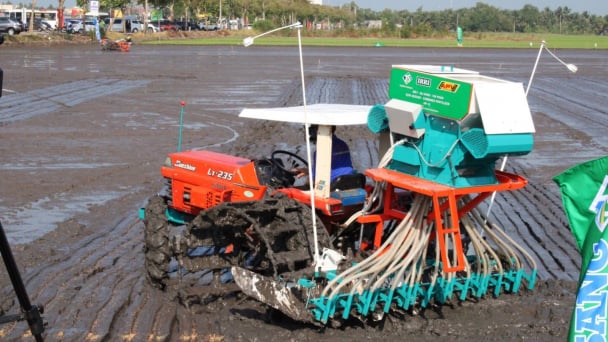
(VAN) The German Agricultural Society (DLG) explores the possibility of establishing a mechanization service center in Vietnam’s Mekong Delta to support farmers in accessing and utilizing advanced machinery.
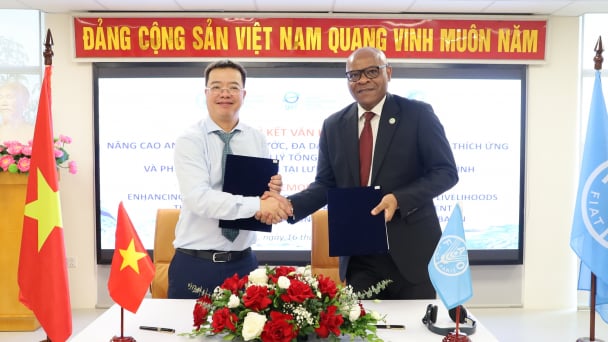
(VAN) On May 16, the Department of Water Resources Management, in collaboration with the Food and Agriculture Organization of the United Nations (FAO), held a signing ceremony for the GEF-8 project document.
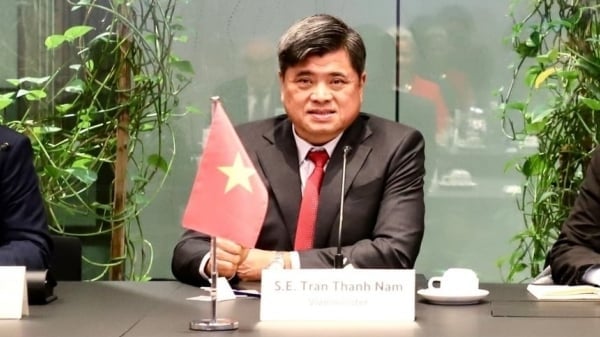
(VAN) Food safety, mechanization, vocational training, and market opening are key areas of cooperation expected between the Vietnamese Government and the Federal Republic of Germany.